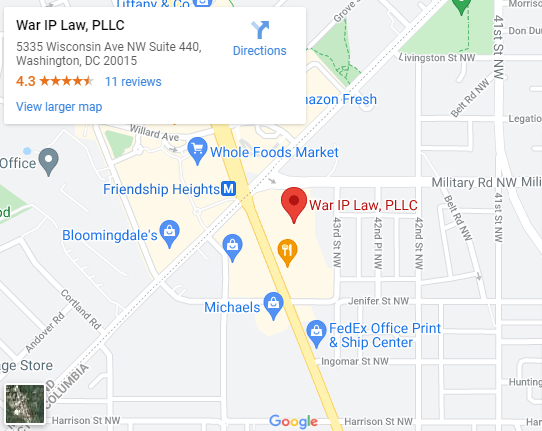In order to manage resources sensibly, it is imperative that brand owners regularly take stock of their trademark portfolios. One of the most succinct ways to perform this analysis is through a trademark audit. But just what is a trademark audit? In short, a trademark audit allows a brand owner to generate savings while focusing resources in core areas. The audit process is complex, so brand owners often outsource audits to outside counsel or seek guidance from a trademark attorney. If you wish to learn more about intellectual property and trademark audits, contact the experienced attorney at War IP Law, PLLC, at (202) 800-3754.
What Is a Trademark Audit?
Trademark audits are done to review a brand owner’s trademark portfolio, including both registered and unregistered (i.e., common law) marks. Ultimately, the goal is to understand how each mark fits into the owner’s marketing and brand strategy. Brand strategies, marketing objectives, and business models change over time, so it is essential to conduct trademark audits on a regular basis to ensure that the brand’s protection strategy lines up with its goals.
How to Conduct an Internal Trademark Audit
Successfully conducting a trademark audit is a multi-step process. The brand owner needs to create their docket, determine how to strengthen it, prioritize their marks, and analyze the overall results of the audit.
Create or Complete a Docket
An audit begins with a review of the brand owner’s docket. The docket is a list of all trademarks, trade names, and service marks. Relevant information to each mark, such as the date of first use and scope of use, is also included.
While dockets are typically limited to registered marks or pending applications, it is wise to include common law marks too. According to the United States Patent and Trademark Office, trademark rights in the United States and other jurisdictions are created by use as opposed to registration. As such, a brand owner could have strong unregistered marks and will be able to make more informed registration decisions if aware of when and how such rights were established.
Strengthen the Docket
Once the docket is finished, the next step is to determine if the trademarks are still in use, how the marks relate to the owner’s goals, and the overall significance of the marks. The docket review process should include the following:
- The services and products related to each mark
- Whether the marks are used and for how long the owner intends to continue using them
- The cost of advertising and promotion under each mark
- The revenue and profit associated with the goods and services under each mark
- Whether the marks are licensed to others
- Whether there are threats to the marks or if they are likely to be infringed upon
With that information in mind, the brand owner can compare the registered mark information with the actual use information to see if registrations do not cover any uses. For unregistered marks, it is helpful to consider whether any registered marks could block potential applications. The strength information gathered during the audit helps in establishing rights if marks need to be defended.
Review License Agreements
In addition to utilizing strength information, the brand owner should also review any outbound trademark license agreements. This will help determine what other entities are allowed to use its marks and whether adequate safeguards are in place. Inbound licenses should also be reviewed in terms of confirming licensed marks that are in use and that the scope of each mark falls within the parameters of the licenses.
Prioritize Your Most Important Marks
Once strength information is obtained, a brand owner has the opportunity to analyze which marks are considered a priority to its business. For brand owners in the United States, a tiered system can be generated for marks. For brand owners with marks in multiple countries, the tiers can be expanded into a grid with marks on one axis and countries on the other.
The grid quadrants delineate the most important from the least important marks. A similar grid is useful for domain names that are related to the marks. Variants may be used on one axis and top-level domains on another to simplify the grid. Overall, the quadrants are useful when it comes time to make broad decisions.
Evaluate the Audit Results
The final step of the trademark audit process is to evaluate the results. Brand owners can use the results to create a protection strategy that simplifies decisions regarding the allocation of future resources. For help in this evaluation, consider contacting the experienced attorneys at War IP Law, PLLC.
It is also useful to develop an implementation plan for the new protection strategy. The plan may include how or when to apply to register unregistered marks that the audit revealed to be significant. It may also start the draft of formal trademark licenses if only implied or oral licenses currently exist, as well as start the process of selling off brands that are no longer of use to the owner.
The audit results could also compel the brand owner to add a house mark to marks previously refused on the basis of confusion. If funding does not allow for registration, the brand owner might consider filing only in the main class so that Trademark Office database searches are more likely to return the marks.
Regarding registered marks that need to be maintained, the brand owner should ensure the necessary information is up-to-date and make changes as required. This avoids expensive refusals if the chain of title becomes outdated or inaccurate filings are accidentally made.
Contact War IP Law, PLLC
With a comprehensive answer to the question, “What is a trademark audit?” brand owners have the knowledge to have strong, more focused trademark and domain name portfolios. Ultimately, there is the potential to further brand objectives and avoid unnecessarily expending resources. If you are struggling with performing a trademark audit, an experienced trademark lawyer can help. Contact the Washing intellectual property attorney at War IP Law, PLLC online or call (202) 800-3754 to learn more.






